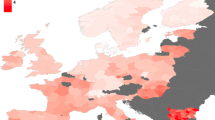Abstract
Public perceptions of crime and victimisation can influence an individual’s subjective well-being. Research into the impact of the fear of crime and victimisation on subjective well-being, however, has been limited; particularly with respect to the relative contributions of real versus perceived crime towards an individual’s self-reported life satisfaction. Improving our understanding of the relationship between crime and well-being is important, as public resources assigned to reducing or controlling crime could be assigned to addressing other social concerns. This paper extends the literature by exploring the contribution of real and perceived crime in an individual’s local area to their self-reported life satisfaction. Our results indicate that: (1) individuals’ perceptions of crime in their local area are far greater than actual levels of crime; (2) the gap between perceived and real crime is widening as real crime rates fall faster than the perceived rate of crime; (3) real crime rates detract more from an individual’s self-reported life satisfaction than perceived rates of crime; however, (4) perceived rates of crime have an adverse impact on life satisfaction beyond those associated with real crime; and (5) there is significant heterogeneity in the life satisfaction effects of real and perceived crime among groups of individuals. These results, together with empirical evidence highlighting successful strategies for moderating perceptions of crime, facilitate the development of more informed public policy that will improve individual life satisfaction and, ultimately, community well-being.




Similar content being viewed by others
Notes
Unless otherwise stated all figures are in AUD. As at 10 August 2013 1 AUD—0.92 USD.
At least two Waves of responses are needed from each individual in order to estimate a fixed effects model.
Exceptions include: Certain diplomatic personnel of overseas governments, customarily excluded from censuses and surveys; overseas residents in Australia (i.e., persons who had stayed or intended to stay in Australia <1 year); members of non-Australian defence forces (and their dependents) stationed in Australia; residents of institutions (such as hospitals and other health care institutions, military and police installations, correctional and penal institutions, convents and monasteries) and other non-private dwellings (such as hotels and motels); and people living in remote and sparsely populated areas.
We take advantage of Mark Schaffer and Steven Stillman’s Stata user written command xtoverid. This is downloadable from the Statistical Software Components Archive using the Stata command "ssc install xtoverid".
References
Adams, R., & Serpe, R. (2000). Social integration, fear of crime, and life satisfaction. Sociological Perspectives, 43(4), 605–629.
Ambrey, C., & Fleming, C. (2013). Life satisfaction in Australia: Evidence from ten years of the HILDA survey. Social Indicators Research,. doi:10.1007/s11205-11012-10228-11200.
Australian Bureau of Statistics. (2012a). Australian standard geographical classification (ASGC) concordances. Catalogue No. 1216.0.15.002. Canberra.
Australian Bureau of Statistics. (2012b). Gender indicators. Catalogue No. 4125,0. Canberra.
Barton, B., Blenker, A., Smith, L., & Speck, R. (2012). Perceptions of crime in the St. Paul Promise Neighborhood. Minneapolis, MN: The Hubert H. Humphrey School of Public Affairs, University of Minnesota.
Becker, G. (1968). Crime and punishment: An economic approach. Journal of Political Economy, 76(2), 169–217.
Bellair, P., & Browning, C. (2010). Contemporary disorganization research: An assessment and further test of the systemic model of neighborhood crime. Journal of Research in Crime and Deliquency, 47(4), 496–521.
Bertrand, M., & Mullainathan, S. (2001). Do people mean what they say? Implications for subjective survey data. The American Economic Review, 91(2), 67–72.
Blanchflower, D., & Oswald, A. (2004). Well-being over time in Britain and the USA. Journal of Public Economics, 88(7–8), 1359–1386.
Brereton, F., Clinch, J., & Ferreira, S. (2008). Happiness, geography and the environment. Ecological Economics, 65(2), 386–396.
Briddell, L. (2009). Rurality and crime: Identifying and explaining rural/urban differences. Doctoral thesis, Pennsylvania State University.
Cameron, A., & Trivedi, P. (2010). Microeconometrics using stata. College Station, TX: Stata Press.
Cobb-Clark, D., & Schurer, S. (2012). The stability of big-five personality traits. Economics Letters, 115(1), 11–15.
Cohen, M. (2008). The effect of crime on life satisfaction. Journal of Legal Studies, 37(s2), s325–s353.
Cornaglia, F., & Leigh, A. (2011). Crime and mental wellbeing. Discussion Paper No. 1049. London: Centre for Economic Performance.
Davies, S., & Hinks, T. (2010). Crime and happiness amongst heads of households in Malawi. Journal of Happiness Studies, 11(4), 457–476.
Davis, B., & Dossetor, K. (2010). (Mis)perceptions of crime in Australia. Trends and Issues in Crime and Criminal Justice No. 396: Australian Institute of Criminology.
Di Tella, R., & MacCulloch, R. (2008). Gross national happiness as an answer to the Easterlin Paradox? Journal of Development Economics, 86(1), 22–42.
Duffy, B., Wake, R., Burrows, T., & Bremner, P. (2008). Closing the gaps—crime and public perceptions. International Review of Law, Computers and Technology, 22(1–2), 17–44.
Ferguson, K., & Mindel, C. (2007). Modeling fear of crime in Dallas neighborhoods: A test of social capital theory. Crime and Delinquency, 53(2), 322–349.
Ferrer-i-Carbonell, A., & Frijters, P. (2004). How important is methodology for the estimates of the determinants of happiness? Economic Journal, 114(497), 641–659.
Frey, B., Luechinger, S., & Stutzer, A. (2009). The life satisfaction approach to valuing public goods: The case of terrorism. Public Choice, 138(3–4), 317–345.
Frey, B., & Stutzer, A. (2002a). Happiness and economics: How the Economy and Institutions Affect Human Well-Being. Princeton: Princeton University Press.
Frey, B., & Stutzer, A. (2002b). What can economists learn from happiness research? Journal of Economic Literature, 40(2), 402–435.
Frijters, P., Haisken-DeNew, J., & Shields, M. (2004). Money does matter! Evidence from increasing real income and life satisfaction in East Germany following reunification. American Economic Review, 94(3), 730–740.
Frijters, P., Johnston, D., & Shields, M. (2011). Life satisfaction dynamics with quarterly life event data. Scandinavian Journal of Economics, 113(1), 190–211.
Geishecker, I., & Riedl, M. (2010). Ordered response models and non-random personalty traits: Monte Carlo simulations and a practical guide. Germany: Centre for European Governance and Economic Development Research.
Gong, H., Cassells, R., & Keegan, M. (2011). Understanding life satisfaction and the education puzzle in Australia: A profile from HILDA wave 9. NATSEM Working Paper No. 11/12. Canberra: University of Canberra.
Helliwell, J. (2003). How’s life? Combining individual and national variables to explain subjective well-being. Economic Modelling, 20(2), 331–360.
Indermaur, D., & Roberts, L. (2005). Perceptions of crime and justice. Australian social attitudes: the first report. Sydney: University of New South Wales Press.
Jackson, J. (2004). Experience and expression: Social and cultural significance in the fear of crime. British Journal of Criminology, 44, 946–966.
King, A., & Maruna, S. (2009). Is a conservative just a liberal who has been mugged? Exploring the origins of punitive views. Punishment and Society, 11, 147–169.
Kuroki, M. (2013). Crime victimization and subjective well-being: Evidence from happiness data. Journal of Happiness Studies, 14(3), 783–794.
MacKerron, G. (2012). Happiness economics from 35 000 feet. Journal of Economic Surveys, 26(4), 705–735.
Margolis, R., & Myrskyla, M. (2010). A global perspective on happiness and fertility. Working Paper No. 2010-025. Rostock: Max Plank Institute for Demographic Research.
Michalos, A. (2003). Policing services and the quality of life. Social Indicators Research, 61(1), 1–18.
Michalos, A., & Zumbo, B. (2000). Criminal victimization and the quality of life. Social Indicators Research, 50(3), 245–295.
Moller, V. (2005). Resilient or resigned? Criminal victimization and quality of life in South Africa. Social Indicators Research, 72(3), 263–317.
Moore, S. (2006). The value of reducing fear: An analysis using the European Social Survey. Applied Economics, 38(1), 115–117.
Moulton, B. (1990). An illustration of a pitfall in estimating the effects of aggregate variables on micro units. Review of Economics and Statistics, 72(2), 334–338.
Oreopoulos, P. (2007). Do dropout drop out too soon? Wealth, health and happiness from compulsory schooling. Journal of Public Economics, 91(11–12), 2213–2229.
Powdthavee, N. (2005). Unhappiness and crime: Evidence from South Africa. Economica, 72(287), 531–547.
Powdthavee, N., & van Praag, B. (2011). Putting different price tags on the same health condition: Re-evaluating the well-being valuation approach. Journal of Health Economics, 30, 1032–1043.
Renaur, B. (2007). Reducing fear of crime: Citizen, police, or government responsibility? Police Quarterly, 10(1), 41–62.
Ross, C., & Jang, S. (2000). Neighborhood disorder, fear and mistrust: The buffering role of social ties with neighbors. American Journal of Community Psychology, 28(4), 401–428.
Shields, M., Price, S., & Wooden, M. (2009). Life satisfaction and the economic and social characteristics of neighbourhoods. Journal of Population Economics, 22(2), 421–443.
Stutzer, A., & Frey, B. (2006). Does marriage make people happy, or do happy people get married? Journal of Socio-Economics, 35(2), 326–347.
Tyler, T., & Boeckmann, R. (1997). Three strikes and you are out, but why? The psychology of public support for punishing rule breakers. Law and Society Review, 31, 237–265.
Veenhoven, R. (1996). Developments in satisfaction research. Social Indicators Research, 37(1), 1–46.
Warr, M. (1982). The accuracy of public beliefs about crime: Further evidence. Criminology, 20(2), 185–204.
Watson, N., & Wooden, M. (2012). The HILDA survey: A case study in the design and development of a successful household panel study. Longitudinal and Life Course Studies, 3(3), 369–381.
Watson, N., & Wooden, M. (2013). Re-engaging with survey non-respondents: Evidence from three household panels. Journal of the Royal Statistical Society: Series A (Statistics in Society). doi:10.1111/rssa.12024.
Weatherburn, D., & Indermaur, D. (2004). Public perceptions of crime trends in New South Wales and Western Australia. In Crime and Justice Bulletin: contemporary issues in Crime and Justice No. 80. New South Wales Bureau of Crime Statistics and Research.
Weatherburn, D., Matka, E., & Lind, B. (1996). Crime perception and reality: Public perceptions of the risk of criminal victimisation in Australia. In Crime and Justice Bulletin: Contemporary issues in Crime and Justice No. 28. Sydney: New South Wales Bureau of Crime Statistics and Research.
Acknowledgments
This research would not have been possible without the data provided by the Australian Government Department of Families, Housing, Community Services and Indigenous Affairs (FaHCSIA), the Australian Bureau of Statistics, and the New South Wales Bureau of Crime Statistics and Research. This paper uses unit record data from the Household, Income and Labour Dynamics in Australia (HILDA) survey. The HILDA project was initiated and is funded by the Australian Government Department of Families, Housing, Community Services and Indigenous Affairs (FaHCSIA) and is managed by the Melbourne Institute of Applied Economic and Social Research (Melbourne Institute). The findings and views reported in this paper, however, are those of the authors and should not be attributed to either FaHCSIA or the Melbourne Institute.
Author information
Authors and Affiliations
Corresponding author
Rights and permissions
About this article
Cite this article
Ambrey, C.L., Fleming, C.M. & Manning, M. Perception or Reality, What Matters Most When it Comes to Crime in Your Neighbourhood?. Soc Indic Res 119, 877–896 (2014). https://doi.org/10.1007/s11205-013-0521-6
Accepted:
Published:
Issue Date:
DOI: https://doi.org/10.1007/s11205-013-0521-6




